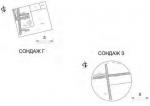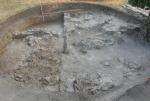Summary (English)
DEULTUM (Krasimira Kostova – kr.kostova@mail.bg) An area of 404 sq. m with strata from 2 m to 4.70 m thick was explored. The excavations in Sondage G revealed that the proto-Bulgarian defensive rampart of the 9th century AD was constructed over a stratum of AD 400 – 450, which was partly destroyed during the excavation of the ditch to the east of the rampart, 3.50 m deep. Part of a wall was explored with foundation dug out into a layer with traces from fire of AD 400 – 450, dated by coins of Honorius and Theodosius II. Sherds were found in the debris from the fire, including from Gothic pottery and amphorae. A floor of a room of the beginning of the 4th century AD was discovered, dated by coins of Constantine the Great. The floor was dug out into a stratum of the 2nd – 3rd centuries AD and laid over the foundations of an earlier building which dated to AD 150 – 250, judging from the coins, and was burned. The fire was dated by a coin of Gordian III and its debris contained fragments from mortar plaster decorated with strips in relief in stucco. After the fire the building was reconstructed: an inner wall built after the middle of the 3rd century AD was discovered. The explorations in Sondage Z revealed a building burned in AD 450 – 475, dated by coins of Theodosius II and Marcian. The debris from the collapsed burned roof covered with tegulae and imbrices was explored. The finds included sherds, including from amphorae of the LR 1, LR 2 and LR 4 Types, and Gothic jugs and pots. A floor of the beginning of the 4th century AD was documented, dated by coins of Constantine the Great and Licinius I. A layer with traces from fire was documented below the floor, dated by coins of Gordian III. A stratum of the 2nd – 3rd centuries AD was discovered, containing sherds from red-gloss jugs, bowls and cups, amphorae of the Dressel 24 and 25 Types, Pontic amphorae, fragments from mortar plaster decorated with strips in relief in stucco, coins of Antoninus Pius, Faustina the Elder and Gordian III.
- Krasimira Kostova - Museum of History – Sredets
Director
Team
Research Body
- Museum of History – Sredets






![Download [PDF]](/excavation/skins/fasti/images/results/download_sml.png)

